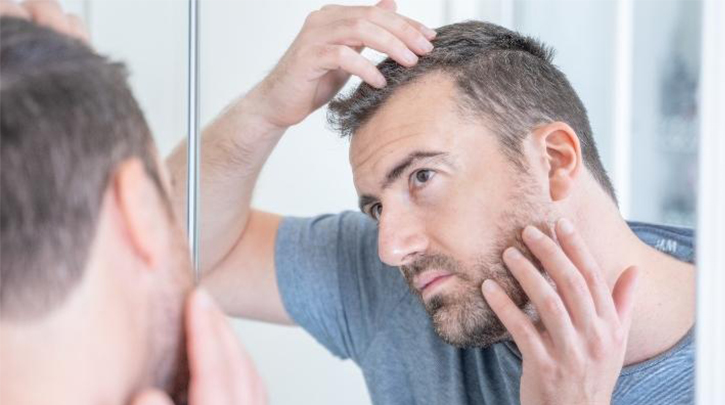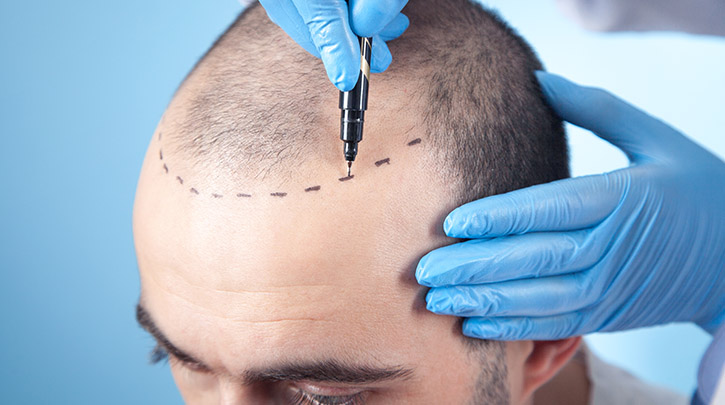




August is National Hair Loss Awareness Month, an initiative designed to bring more attention to the detection, prevention, and treatment of a concern that many face. The main goal of awareness efforts such as this one is to encourage people to talk freely about the issue and share information that could help, in this case, solutions for hair restoration. Hair loss is incredibly common, but many sufferers avoid seeking treatments because they are self-conscious about the issue itself. However, hair loss is nothing to be ashamed of, and there are amazing restoration options available. Below, we cover the causes of hair loss, and three solutions anyone concerned about hair loss should know about.
Hair loss affects both men and women. It’s estimated that by the age of 35, as many as two-thirds of American men will suffer from some degree of noticeable hair loss, and approximately 85% of American men experience thinning hair by the age of 50. As many as 30 million women in the U.S. alone report experiencing some sort of hair loss as well. The emotional repercussions associated with hair loss are significant and tend to overshadow all areas of life, including dating and one’s professional career and social life. The impact of hair loss comes as especially unfair considering that, in the majority of cases, the hair loss is not the sufferer’s fault.
Your susceptibility to hair thinning and loss, especially at an early age, is primarily genetic. In scientific terms, hair loss can be tied directly to a hormone called dihydrotestosterone, or DHT. For people (especially men) with a higher sensitivity to DHT, the hormone causes hair follicle shrinkage, leading to weaker hair, and eventually, less hair growth. DHT-related hair loss typically manifests as a receding hairline, thinner hair, and the telltale bald spot at the crown of the head.
Beyond genetics, lifestyle factors can impact how long you can maintain a thick head of hair. Stress has been shown to trigger hair loss, so taking care of your mind and your physical well-being is important. For women, life events that cause major hormonal shifts, like pregnancy and menopause, contribute to thinning hair as well. Unlike with genetic causes, sometimes hair loss due to external factors will grow back over time—but all too often, once the hair is gone, it’s gone for good.
If you’ve tried first-line solutions to hair loss such as dietary changes, topical products, and supplements to no avail, you may want to consider a prescription medication such as Minoxidil (brand name Rogaine) or Finasteride (brand name Propecia). The benefit of medications such as these is that they restore the hair to some extent without requiring surgery, and they aren’t especially costly. The cons are mainly the unpleasant side effects that can occur when taking the medication, which include itching, depression, sexual dysfunction, and temporary hair loss known as “shedding.” While these are worth trying, the truth is that medications may not be effective at restoring your hair to its prior glory. A key feature to know about hair loss is that it’s not just that the hair is falling out. Hair loss means that the follicle, which generates hair growth and anchors the root of the hair to the scalp, is no longer viable. In this case, surgical hair restoration is the only way to completely restore the hair.
In FUT surgery, a surgeon cuts a strip of skin from the back or side of your head and extracts individual hair follicles. These follicles are then inserted into the balding parts of your scalp. During FUT, a surgeon cuts a strip of skin from your scalp, usually from the back of your head. Individual follicles are then removed from the strip for transplantation in the areas where more hair is desired. After the procedure, the hair grows as normal. While this method does offer permanent hair restoration, it has drawbacks such as the linear scar at the site of the strip removal; it requires stitches, a longer recovery time, and the procedure itself can be quite painful. For these reasons and more, many surgeons recommend the FUE method for hair restoration instead.
Follicular Unit Extraction (FUE) is the new gold standard in hair restoration. During an FUE session, the treatment provider extracts individual hair follicles from the back or sides of the head using a specialized device and then implants them in the area where more hair growth is desired. The newly implanted hair follicles continue the natural hair growth cycle, and results improve each week with full realization at 9-12 months post-procedure. Unlike earlier methods such as FUT, FUE procedures are minimally invasive, enable a faster recovery process, and leave no linear scarring. The only drawback to the FUE method is that it necessitates shaving of the donor area; a shortfall that most patients are happy to overlook when they see the outstanding results of their hair restoration procedure.
Venus Concept offers two state-of-the-art devices for hair restoration, NeoGraft® and ARTAS®. Both use the FUE method and enhance it even further using robotics, automation, and AI integration for a seamless experience with no scalpels, no linear scarring, and a quicker healing time. With either device, your results will be natural-looking and long-lasting—our procedures boast an average 94% "Worth It” rating from patients on RealSelf.com.
During a NeoGraft® hair restoration treatment, the treatment provider extracts individual hair follicles from the back or sides of the head using a specialized device and then implants them in the area where more hair growth is desired. The newly implanted hair follicles continue the natural hair growth cycle and results improve each week, with full realization at 9-12 months post-procedure. Unlike previous methods, which involved surgically removing a strip from the back of the patient’s scalp and grafting it to a new area, this procedure is minimally invasive for a faster recovery process and no linear scarring.
ARTAS® Robotic Hair Restoration Treatments use the FUE method as well, except in this case using, Artificial Intelligence (AI) to design the ideal extraction and placement of the hair follicles. The device’s precision and speed protect your existing hair and maintain a natural appearance for the newly implanted hair. Both devices ensure that you can restore your hair discreetly and successfully, with long-lasting results that look great.
Let National Hair Loss Awareness month be your jumping-off point to a happier, more confident you. Our certified treatment providers will work with you to create a hair restoration plan that works with your aesthetic goals and lifestyle. Speak to an expert near you today by using the search field below.
Find a certified Venus Treatments provider near you today who specializes in today’s top aesthetic medical solutions.



Search below to find a provider near you and to learn about our non-surgical aesthetic treatments with ARTAS®, NeoGraft®, Venus Bliss™, Venus Versa™, Venus Legacy™, Venus Velocity™, Venus Viva™ MD, Venus Freeze Plus™, and Venus Glow™.
For more information call: +61 416 022 096 // [email protected] // Suite 3.06/ Level 3 20 Rodbourgh Road, Frenchs Forest NSW 2086, Australia
REGULATORY CLEARANCES [ More ]
Venus Versa™ has CE Mark as a multi-application device intended to be used in aesthetic and cosmetic procedures. The SR515 and SR580 applicators have CE Mark for the treatment of benign pigmented epidermal and cutaneous lesions and treatment of benign cutaneous vascular lesions. The HR650/HR650XL and HR690/HR690XL applicators have CE Mark for the removal of unwanted hair and to effect stable long-term or permanent hair reduction for Fitzpatrick skin types I-IV. The AC Dual applicator has CE Mark for the treatment of acne vulgaris. The DiamondPolar™ applicator has CE Mark for non-invasive treatment of moderate to severe facial wrinkles and rhytides on females with Fitzpatrick skin types I-IV. The OctiPolar™ applicator on the Venus Versa™ system has CE Mark for temporary body contouring via skin tightening, circumferential reduction, and cellulite reduction. The NanoFractional RF™ (Viva) applicator has CE Mark for dermatological procedures requiring ablation and resurfacing of the skin.
NeoGraft® 2.0 has CE Mark and TGA with indication for use in suction-assisted follicular extraction and re-implantation for males and females.
The ARTAS iX™ from Restoration Robotics® is indicated for harvesting hair follicles from the scalp in men diagnosed with androgenic alopecia (male pattern hair loss) who have black or brown straight hair. The ARTAS iX™ from Restoration Robotics® is intended to assist physicians in identifying and extracting hair follicular units from the scalp during hair transplantation; creating recipient sites; and implanting harvested hair follicles.
Venus Epileve™ has CE Mark for hair removal, permanent hair reduction (defined as the long-term stable reduction in the number of hairs re-growing when measured at 6, 9 and 12 months after the completion of a treatment regimen), and the treatment of pseudofolliculitis barbae for all Fitzpatrick skin types. Venus Epileve™ is also CE-Marked for hirsutism.
Venus Legacy™ has CE Mark for the temporary increase of skin tightening, circumferential reduction, cellulite reduction, and wrinkle reduction.
Venus Velocity™ has CE Mark for hair removal, permanent hair reduction (defined as the long-term stable reduction in the number of hairs re-growing when measured at 6, 9 and 12 months after the completion of a treatment regimen), and the treatment of pseudofolliculitis barbae for all Fitzpatrick skin types.
Venus Viva™ has CE Mark for the use in dermatologic and general surgical procedures requiring ablation and resurfacing of the skin, and the treatment of moderate to severe facial wrinkles and rhytides in Fitzpatrick skin types I-IV with the DiamondPolar™ applicator.
Venus Freeze Plus™ has CE Mark for treatment of moderate to severe facial wrinkles and rhytides using the DiamondPolar™ applicator, and CE Mark for the treatment of cellulite reduction, increase of skin tightening, and temporary circumferential reduction on the OctiPolar™ applicator.
Venus Freeze™ has CE Mark for treatment of moderate to severe facial wrinkles and rhytides using the DiamondPolar™ applicator, and CE Mark for the treatment of cellulite reduction, increase of skin tightening, and temporary circumferential reduction on the OctiPolar™ applicator.
Venus Glow™ provides a dermal rejuvenation treatment that works to open up and deep-clean pores. Venus Concept is the exclusive distributor for Venus Glow™.
Copyright © 2025 Venus Concept. All rights reserved.
You are entering our website. For other country/regions and language options, please click the button below.
Click HereAre you a physician or aesthetician? Please visit our medical and aesthetic professional website to learn more.
Click Here